
The way Google calculates the climate impact of your flights has changed, the BBC has discovered. Flights now appear to have much less impact on the environment than before. That’s because the world’s biggest search engine has taken a key driver of global warming out of its online carbon flight calculator.
“Google has airbrushed a huge chunk of the aviation industry’s climate impacts from its pages” says Dr Doug Parr, chief scientist of Greenpeace.
With Google hosting nine out of every 10 online searches, this could have wide repercussions for people’s travel decisions.
The company said it made the change following consultations with its “industry partners”.
It affects the carbon calculator embedded in the company’s “Google Flights” search tool.

If you have ever tried to find a flight on Google, you will have come across Google Flights.
It appears towards the top of search results and allows you to scour the web for flights and fares.
It also offers to calculate the emissions generated by your journey.
Google says this feature is designed “to help you make more sustainable travel choices”.
Yet in July, Google decided to exclude all the global warming impacts of flying except CO2.
Some experts say Google’s calculations now represent just over half of the real impact on the climate of flights.
“It now significantly understates the global impact of aviation on the climate”, says Professor David Lee of Manchester Metropolitan University, the author of the most comprehensive scientific assessment of the contribution of air travel to global warming.
Flying affects the climate in lots of ways in addition to the CO2 produced by burning aviation fuel.
These include the creation of long thin clouds high up in the atmosphere – known as contrails – which trap heat radiated by the Earth, leading to a net warming effect on our planet.
These additional warming impacts mean that although aviation is only responsible for around 2% of global CO2 emissions, the sector is actually responsible for around 3.5% of the warming caused by human activity.
And it is a sector that is only going to get bigger.
Since 2000 emissions have risen by 50%, and the industry is expected to grow by more than 4% every year for the next two decades, according to the International Energy Agency (IEA).

Google is open about its calculations for the tool – posting the methodology on a US software website called GitHub.
The BBC was alerted to the fact that it had posted a note saying it was changing how it assesses the impact of aviation.












Social Profiles